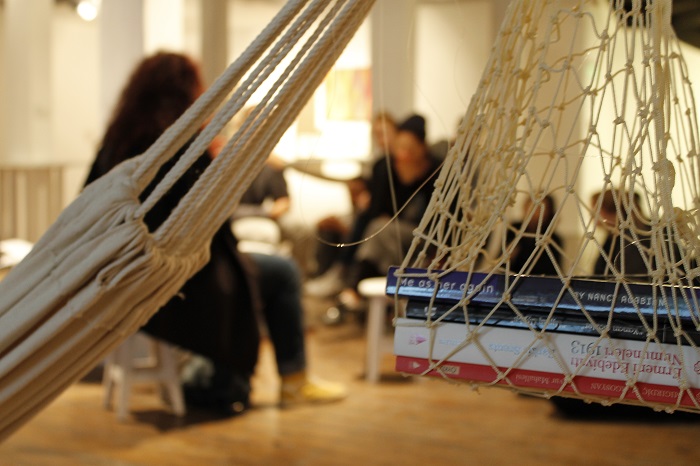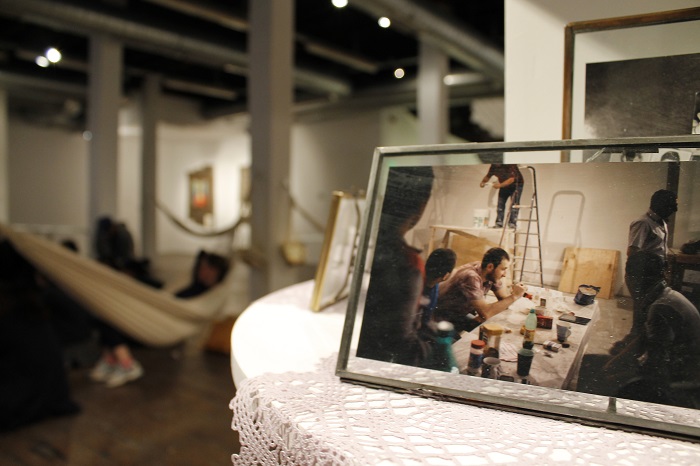“Grandchildren” and the question of common ground
From September 3rd to November 1st 2015, DEPO Istanbul is hosting the exhibition „Grandchildren – new geographies of belonging“, created by thirteen artists from different countries, albeit all of them having armenian origins curated by Silvina Meguerditchian. DEPO is a space of exhibition, discourse and encounter in Istanbul’s Tophane district and focuses on cooperation and exchange between artists as well as the social-political impact of artistic action.
The artists contributing to “Grandchildren” had joined in discussions, workshops and symposiums since 2006 to explore a common way of expressing their often very different experiences and stances.
Thus sharing a background of escape and displacement as well as the heritage of armenian identity, it turned out during the working process that the similarities in views and approaches weren’t so numerous after all, says curator and contributing artist Silvina Der-Meguerditchian.
Growing up in different countries and under different systems and influences, the artists vary not only in mindset and mother tongue, but also in their artistic languages.
The exhibition consists of painting, installation, photography, performance, sculpture and video art. Each participant made a very personal and subjective approach to the matter of belonging and memory, and it is also that diversity that makes the exhibition rich and expressive.
However, the arrangement of these “islands”, as Silvina Der-Meguerditchian describes the individual exhibits, manages not only to underline the diversity of views, but also to build and underline connections in matter and form. Some of these “islands” are linked by a raw of slender tables, that remind of bridges and are, themselves, exhibiting space, for example for the works of Marie Zolamian. For her painting cycle “biz her yerde (we everywhere)”, she set a family in the same pose – only changed in clothing and position in the picture – into multiple landscapes drawn from old photographs. While landscape differs in every picture, the family remains unchanged; untouched by it’s surrounding.
Another work by french/armenian Achot Achot focuses on wounds and their healing: He arranged several patterns of different size, all of them painted in skin colour and than inflicted with “scratches” of red paint. A video-projection in the background shows the soles of bare feet that are slowly doused with oil, honey and seeds. Watching the meditative, repetitive video has a calming and comforting effect that is almost physical and contrasts the painted close-ups of open wounds on the table behind. Scout Tufankjian took photographs of families living in armenian Diaspora communities in 20 countries for his “Armenian Diaspora Project” and arranged some of them in an installation for “Grandchildren”.
[widgetkit id=19859]
Project coordinator and curator Silvina Der-Meguerditchian says that, despite the graveness of the matter, she didn’t want the atmosphere of the exhibition to be primarily sad. It was rather the fact of an armenian present that needed to be put into focus, rather the livelyhood and resisting strength of armenian culture than it’s losses to terror. For one of her pieces, she arranged videotapes of people dancing traditional armenian dances in cities all around the world. The activity and presence physically expressed through dancing turned out to be a productive theme.
Also her other works on this first floor invite to a rather active involvement with the exhibition: A table covered with books from and about Armenia, a (filled) teakettle next to an iPad with armenian music, hammocks spun around the room, with nets full of books next to them. As she explains to a group of visitors, she wanted people to spend time in these rooms and really engage in the culture.
On the second floor, whereas the more sinister parts of the exhibition are located, Der-Meguerditchian set up the „room of sorrow“, a very private and associative collaboration of the artists. Offering no further explanations but only the names of the artists next to their works and a plain label saying „room of sorrow“ at the entrance, it really allows the viewer into an atmosphere of intimacy. Even though “Grandchildren” generally aims towards life and presence, this part of armenian history also needed a space of reflection and remembrance.
[widgetkit id=19873]
The exhibition really is characterized by carefully aligned tensions, such as this one between memory and prospect, but also by the constant handling of disparities and common ground the artists experienced already in their working process. It might rise questions of identity and belonging rather than answering them. However, these questions – questions of discplacement, remembrance and the struggle of a culture threatened by violence and forced escape – draw their currentness not only from the recent 100th “anniversary” of the armenian genocide. They could barely be more urgent.
Silvina Der-Meguerditchian was born and raised in Buenos Aires, Argentina. Her grandparents lived in Antep and Sivas, nowadays Turkey, before they had to escape their homes. After a turbulent journey, which led them I.a. through Lebanon and Syria, they met and married in Paris and left Europe in the 1930s to escape, again, from WWII. Silvina grew up in an argentinian Diaspora-community and moved to Berlin when she was 21.
Her works deal with problems such as national identity, minorities and remembrance. She also acts as a networker between contemporary armenian artists throughout the world. She’s been awarded with several scholarships and exhibited around the world. Currently, she is an artist-in-resident at Kulturakademie Tarabya, Istanbul, a program of the Goethe Institut und the German Foreign Ministry.
Photos by Maximiliane Schneider


